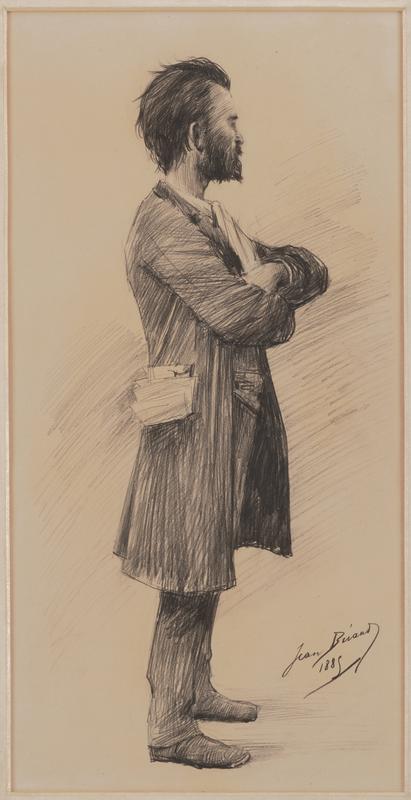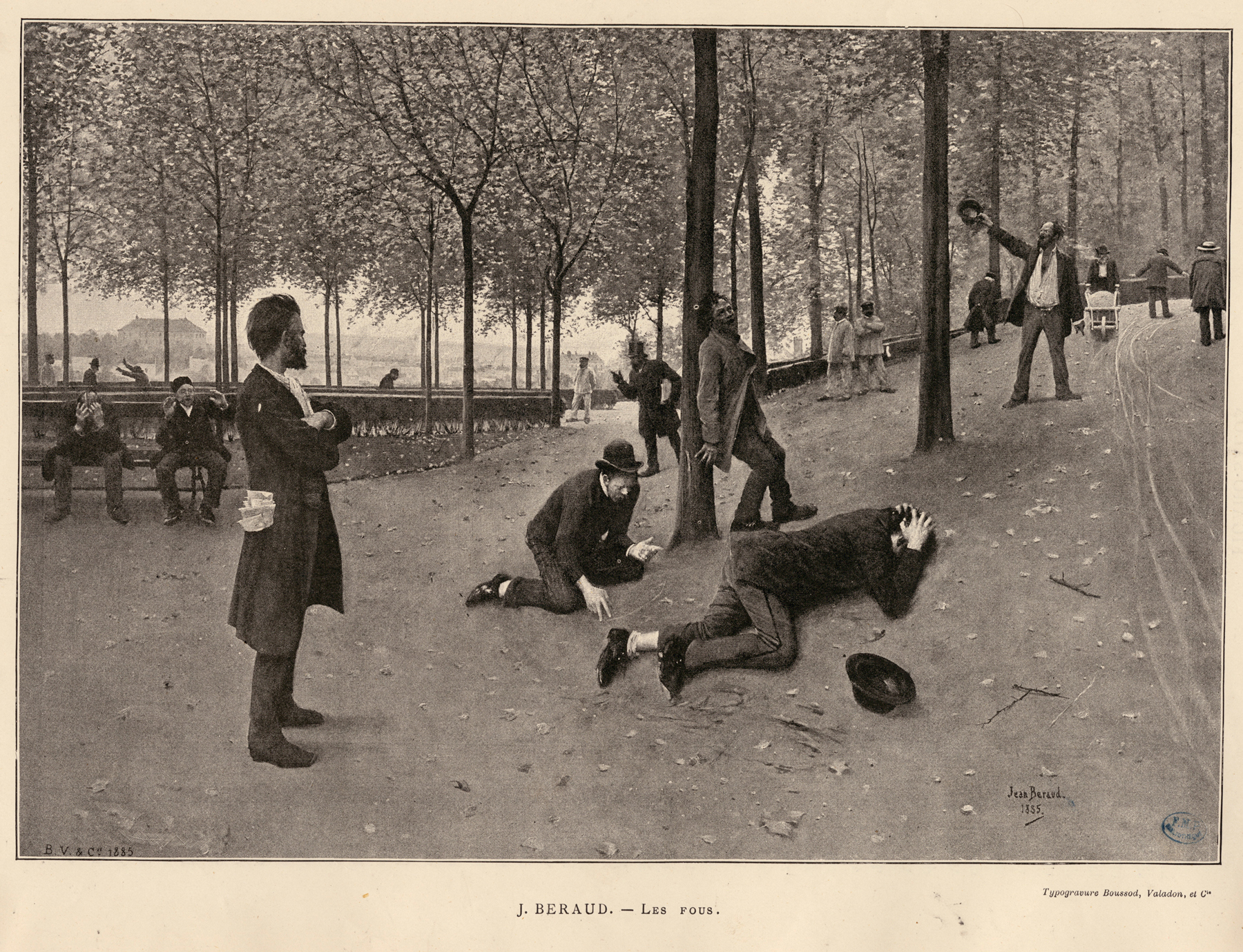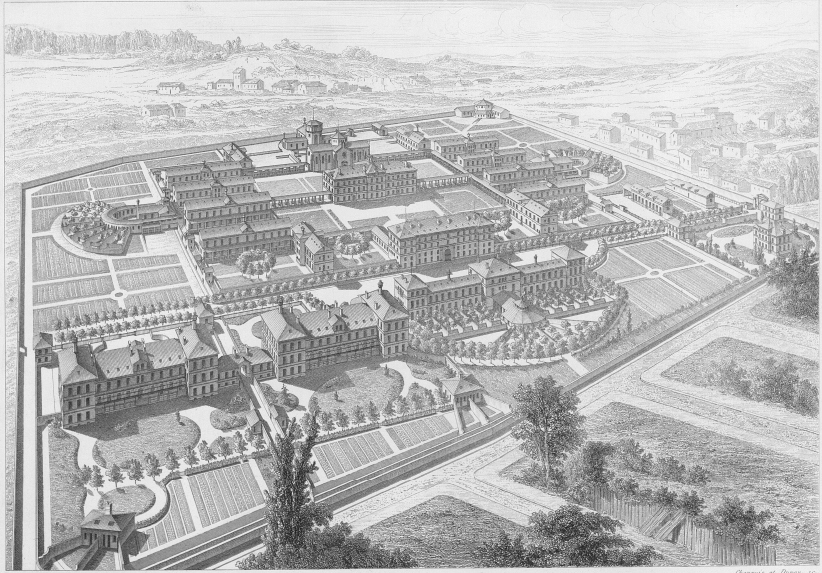
18. Jean Béraud, The Mad Writer, Study for “Les fous”
| Artist | Jean Béraud, French (born Russia), Saint Petersburg 1849–Paris 1935 |
| Title, Date | The Mad Writer, Study for “Les fous”, 1885 |
| Medium | Black chalk |
| Dimensions | 18 5/16 × 10 13/16 in. (46.5 × 27.5 cm) |
| Inscriptions + Marks | Lower right: Jean Béraud / 1885 |
| Provenance | Sale, L’esprit du XIXe siècle, Osenat, Fontainebleau, France, November 20–22, 2015, no. 8; [Mathieu Néouze, Paris, until 2016; to Weisberg]; Yvonne and Gabriel Weisberg, Minneapolis |
| Exhibition History | "Reflections on Reality: Drawings and Paintings from the Weisberg Collection," Mia, 2022–23 |
| References | "Oeuvres sur papier 1880–1930" (exh. cat.), Mathieu Néouze, Paris (March 2016), no. 1, ill. |
| Credit Line | Promised gift of Gabriel P. and Yvonne M.L. Weisberg, Minneapolis |


Few cities indulged in life’s pleasures more thoroughly than Paris in the second half of the nineteenth century. Jean Béraud faithfully documented the beau monde’s fashionable haunts, but occasionally he turned his attention to those on society’s fringes. The present sheet is a preparatory study for a figure in the painting Les fous, usually translated as “the madmen,” which was a prominent entry in the Salon of 1885. Although the painting remains lost, it was reproduced in an engraving (fig. 1).1 The Weisberg drawing closely resembles the figure in the print, but the print also reflects several small adjustments Béraud made at the painting stage—darkening the coat, narrowing its hem, reducing the jut of the figure’s left elbow, and turning his face more to the left.
Who is this man? What is his role? The scene takes place in the parklike grounds of Saint Anne’s Asylum (fig. 2), a hospital built in the 1800s in Paris’s fourteenth arrondissement to research and treat mental illnesses. The figure in the drawing stands in the foreground, watching the mental torments of patients who writhe on the ground, buckle against a tree, or vigorously gesticulate. From a twenty-first-century perspective, one might assume that the man is a physician who observes his patients and keeps notes in his pocket. Béraud’s contemporaries saw him differently. In his coverage of the Salon, the prominent art critic Paul Mantz wrote in Les Temps: “Ici est le poète à la barbe inculte qui se promène fièrement, l’esprit plein de rêves et la poche bourrée de manuscrits” (Here is the poet with the uncultivated beard who walks proudly, his mind full of dreams and his pocket stuffed with manuscripts).2 Indeed, a closer look reveals a scruffiness unsuited to Paris’s professional class of the time. The title Mad Writer, though perhaps out of keeping with our time, suggests how this image was seen when it first appeared.
Béraud’s father, a sculptor, was working on a church in Russia when Béraud was born. When he was about four years old, his father died and the family returned to Paris. Béraud planned on a career in law, but Prussia’s siege of Paris, which began September 20, 1870, disrupted his studies. He was part of the garde mobile (mobile guard), a largely conscripted force of inexperienced and underequipped soldiers. After the armistice of January 26, 1871, he studied painting in the studio of Léon Bonnat. Starting as a portraitist, he built a clientele among Franco-Russian aristocrats and expanded his repertoire to encompass the affairs of Parisian high society. Béraud exhibited regularly at the Paris Salon (1873–89), then with the Société Nationale des Beaux-Arts (1890–1929). Among his honors was a gold medal at the Paris Exposition Universelle of 1889.
TER
Notes
La Maison Braun & Cie, Paris, also marketed a lantern slide of Béraud’s composition ↩︎
Paul Mantz, “Le Salon, VI,” in Les Temps, June 14, 1885. ↩︎